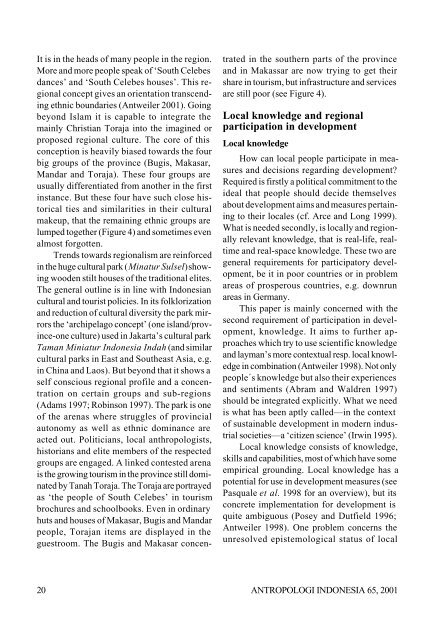Transethnic Identity and Urban Cognition in Makassar: - Antropologi ...
Transethnic Identity and Urban Cognition in Makassar: - Antropologi ...
Transethnic Identity and Urban Cognition in Makassar: - Antropologi ...
Create successful ePaper yourself
Turn your PDF publications into a flip-book with our unique Google optimized e-Paper software.
It is <strong>in</strong> the heads of many people <strong>in</strong> the region.<br />
More <strong>and</strong> more people speak of ‘South Celebes<br />
dances’ <strong>and</strong> ‘South Celebes houses’. This regional<br />
concept gives an orientation transcend<strong>in</strong>g<br />
ethnic boundaries (Antweiler 2001). Go<strong>in</strong>g<br />
beyond Islam it is capable to <strong>in</strong>tegrate the<br />
ma<strong>in</strong>ly Christian Toraja <strong>in</strong>to the imag<strong>in</strong>ed or<br />
proposed regional culture. The core of this<br />
conception is heavily biased towards the four<br />
big groups of the prov<strong>in</strong>ce (Bugis, Makasar,<br />
M<strong>and</strong>ar <strong>and</strong> Toraja). These four groups are<br />
usually differentiated from another <strong>in</strong> the first<br />
<strong>in</strong>stance. But these four have such close historical<br />
ties <strong>and</strong> similarities <strong>in</strong> their cultural<br />
makeup, that the rema<strong>in</strong><strong>in</strong>g ethnic groups are<br />
lumped together (Figure 4) <strong>and</strong> sometimes even<br />
almost forgotten.<br />
Trends towards regionalism are re<strong>in</strong>forced<br />
<strong>in</strong> the huge cultural park (M<strong>in</strong>atur Sulsel) show<strong>in</strong>g<br />
wooden stilt houses of the traditional elites.<br />
The general outl<strong>in</strong>e is <strong>in</strong> l<strong>in</strong>e with Indonesian<br />
cultural <strong>and</strong> tourist policies. In its folklorization<br />
<strong>and</strong> reduction of cultural diversity the park mirrors<br />
the ‘archipelago concept’ (one isl<strong>and</strong>/prov<strong>in</strong>ce-one<br />
culture) used <strong>in</strong> Jakarta’s cultural park<br />
Taman M<strong>in</strong>iatur Indonesia Indah (<strong>and</strong> similar<br />
cultural parks <strong>in</strong> East <strong>and</strong> Southeast Asia, e.g.<br />
<strong>in</strong> Ch<strong>in</strong>a <strong>and</strong> Laos). But beyond that it shows a<br />
self conscious regional profile <strong>and</strong> a concentration<br />
on certa<strong>in</strong> groups <strong>and</strong> sub-regions<br />
(Adams 1997; Rob<strong>in</strong>son 1997). The park is one<br />
of the arenas where struggles of prov<strong>in</strong>cial<br />
autonomy as well as ethnic dom<strong>in</strong>ance are<br />
acted out. Politicians, local anthropologists,<br />
historians <strong>and</strong> elite members of the respected<br />
groups are engaged. A l<strong>in</strong>ked contested arena<br />
is the grow<strong>in</strong>g tourism <strong>in</strong> the prov<strong>in</strong>ce still dom<strong>in</strong>ated<br />
by Tanah Toraja. The Toraja are portrayed<br />
as ‘the people of South Celebes’ <strong>in</strong> tourism<br />
brochures <strong>and</strong> schoolbooks. Even <strong>in</strong> ord<strong>in</strong>ary<br />
huts <strong>and</strong> houses of Makasar, Bugis <strong>and</strong> M<strong>and</strong>ar<br />
people, Torajan items are displayed <strong>in</strong> the<br />
guestroom. The Bugis <strong>and</strong> Makasar concen-<br />
trated <strong>in</strong> the southern parts of the prov<strong>in</strong>ce<br />
<strong>and</strong> <strong>in</strong> <strong>Makassar</strong> are now try<strong>in</strong>g to get their<br />
share <strong>in</strong> tourism, but <strong>in</strong>frastructure <strong>and</strong> services<br />
are still poor (see Figure 4).<br />
Local knowledge <strong>and</strong> regional<br />
participation <strong>in</strong> development<br />
Local knowledge<br />
How can local people participate <strong>in</strong> measures<br />
<strong>and</strong> decisions regard<strong>in</strong>g development?<br />
Required is firstly a political commitment to the<br />
ideal that people should decide themselves<br />
about development aims <strong>and</strong> measures perta<strong>in</strong><strong>in</strong>g<br />
to their locales (cf. Arce <strong>and</strong> Long 1999).<br />
What is needed secondly, is locally <strong>and</strong> regionally<br />
relevant knowledge, that is real-life, realtime<br />
<strong>and</strong> real-space knowledge. These two are<br />
general requirements for participatory development,<br />
be it <strong>in</strong> poor countries or <strong>in</strong> problem<br />
areas of prosperous countries, e.g. downrun<br />
areas <strong>in</strong> Germany.<br />
This paper is ma<strong>in</strong>ly concerned with the<br />
second requirement of participation <strong>in</strong> development,<br />
knowledge. It aims to further approaches<br />
which try to use scientific knowledge<br />
<strong>and</strong> layman’s more contextual resp. local knowledge<br />
<strong>in</strong> comb<strong>in</strong>ation (Antweiler 1998). Not only<br />
people´s knowledge but also their experiences<br />
<strong>and</strong> sentiments (Abram <strong>and</strong> Waldren 1997)<br />
should be <strong>in</strong>tegrated explicitly. What we need<br />
is what has been aptly called—<strong>in</strong> the context<br />
of susta<strong>in</strong>able development <strong>in</strong> modern <strong>in</strong>dustrial<br />
societies—a ‘citizen science’ (Irw<strong>in</strong> 1995).<br />
Local knowledge consists of knowledge,<br />
skills <strong>and</strong> capabilities, most of which have some<br />
empirical ground<strong>in</strong>g. Local knowledge has a<br />
potential for use <strong>in</strong> development measures (see<br />
Pasquale et al. 1998 for an overview), but its<br />
concrete implementation for development is<br />
quite ambiguous (Posey <strong>and</strong> Dutfield 1996;<br />
Antweiler 1998). One problem concerns the<br />
unresolved epistemological status of local<br />
20 ANTROPOLOGI INDONESIA 65, 2001


